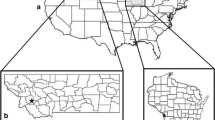Abstract
Allopatric infections of French Galba truncatula with an Argentinean isolate of Fasciola hepatica were carried out to determine the infectivity of foreign miracidia in three snail populations differing by their susceptibility to French miracidia (two highly and one poorly susceptible populations). Sympatric infections of G. truncatula with French miracidia were used as controls. Compared to sympatric infections of G. truncatula, snail survival at day 30 post-infection in allopatric groups was significantly lower in a highly susceptible population and significantly greater in the other two. Prevalence in snails infected with the allopatric isolate was significantly lower (16.4–34.5 % instead of 58.6–72.1 %), whereas their patent period was significantly longer (a mean of 69.9–85.9 days instead of 6.4–20.7 days). The mean number of metacercariae was also higher in allopatric groups (236.5–897.3 per cercariae-shedding snail instead of 70.7–222.1). Owing to longer patent periods, the Argentinean isolate of F. hepatica was less pathogenic for these snails. The lower prevalence of infection, the longer patent period and the higher number of metacercariae noted in allopatric groups might be the consequence of an adaptive mechanism used by this digenean introduced to the New World to infect new populations of unusual intermediate hosts.
Similar content being viewed by others
References
Boray JC (1966) Studies on the relative susceptibility of some lymnaeids to infection with Fasciola hepatica and F. gigantica and on the adaptation of Fasciola spp. Ann Trop Med Parasitol 60:114–124
Boray JC (1969) Experimental fascioliasis in Australia. Adv Parasitol 7:95–210
Coelho LHL, Lima WS, Guimaraes MP (2009) Sympatric and allopatric combinations of Lymnaea columella and Fasciola hepatica from southern and south-eastern Brazil. J Helminthol 83:285–288
Dreyfuss G, Vareille-Morel C, Rondelaud D (1997) Les habitats de Lymnaea truncatula Müller (Mollusque) le long de deux rivières. Ann Limnol-Int J Limnol 33:67–72
Dreyfuss G, Vignoles P, Rondelaud D (2007) Fasciola hepatica: the infectivity of cattle-origin miracidia had increased over the past years in central France. Parasitol Res 101:1157–1160
Gasnier N, Rondelaud D, Abrous M, Boulard C, Carreras F, Diez-Banos P, Cabaret J (2000) Allopatric combination of Fasciola hepatica and Lymnaea truncatula is more efficient than sympatric ones. Int J Parasitol 30:573–578
Goumghar MD, Dreyfuss G, Rondelaud D, Benlemlih M, Cabaret J (2001) More efficient allopatric combinations of Fasciola hepatica and Lymnaea truncatula due to modification of redial development? Parasitol Res 87:1016–1019
Greischar MA, Koskella B (2007) A synthesis of experimental work on parasite local adaptation. Ecol Lett 10:418–434
Hoeksema JD, Forde SF (2008) A meta-analysis of factors affecting local adaptation between interacting species. Am Nat 171:275–290
King KC, Jokela J, Lively CM (2011) Trematode parasites infect or die in snail hosts. Biol Lett 23:265–268
Laguna Sanz E (1991) El ganado español, un desccubriemto para América. Ministerio de Agricultura, Pesca y Alimentación, Madrid
Mas-Coma S, Funatsu IR, Bargues MD (2001) Fasciola hepatica and lymnaeid snails occurring at very high altitude in South America. Parasitology 123:115–127
Mas-Coma S, Valero MA, Bargues MD (2009) Fasciola, lymnaeids and human fascioliasis, with a global overview on disease transmission, epidemiology, evolutionary genetics, molecular epidemiology and control. Adv Parasitol 69:44–146
Ollerenshaw CB (1971) Some observations on the epidemiology of fascioliasis in relation to the timing of molluscicide applications in the control of the disease. Vet Rec 88:152–164
Osnas EE, Lively CM (2011) Parasite dose, prevalence of infection and local adaptation in a host-parasite system. Parasitol Res 109:675–687
Rondelaud D, Vignoles P, Dreyfuss G (2009) La Limnée tronquée, un mollusque d’intérêt médical et vétérinaire. PULIM, Limoges, 283 pp
Rondelaud D, Dreyfuss G, Vareille-Morel C, Moukrim A (1997) Les populations de Lymnaea truncatula Müller vivant sur les berges des rivières. Étude expérimentale de leur aptitude à l’infestation par Fasciola hepatica Linné. Rev Méd Vét (Toul) 148:329–332
Rondelaud D, Fousi M, Vignoles P, Moncef M, Dreyfuss G (2007) Optimization of metacercarial production for three digenean species by the use of Petri dishes for raising lettuce-fed Galba truncatula. Parasitol Res 100:861–865
Rondelaud D, Hourdin P, Vignoles P, Dreyfuss G, Cabaret J (2011) The detection of snail host habitats in liver fluke infected farms by use of plant indicators. Vet Parasitol 181:166–173
Rondelaud D, Mouzet R, Vignoles P, Dreyfuss G, Cabaret J (2013) The production of mammalian trematode infective stages by the snail Galba truncatula. J Helminthol (in press)
Vignoles P, Ménard A, Rondelaud D, Chauvin A, Dreyfuss G (2001) Fasciola hepatica: the characteristics of experimental infections in Lymnaea truncatula subjected to miracidia differing in their mammalian origin. Parasitol Res 87:945–949
Vignoles P, Rondelaud D, Dreyfuss G (2011) Characteristics of Fasciola hepatica infections in Galba truncatula originating from riverbank populations. J Helminthol 85:28–32
Walker SM, Hoey E, Fletcher H, Brennan G, Fairweather I, Trudgett A (2006) Stage-specific differences in fecundity over the life-cycle of two characterized isolates of the liver fluke, Fasciola hepatica. Parasitology 133:209–216
Author information
Authors and Affiliations
Corresponding author
Rights and permissions
About this article
Cite this article
Sanabria, R., Mouzet, R., Courtioux, B. et al. Comparative strategies and success of sympatric and allopatric Fasciola hepatica infecting Galba truncatula of different susceptibilities. Parasitol Res 112, 2255–2259 (2013). https://doi.org/10.1007/s00436-013-3385-4
Received:
Accepted:
Published:
Issue Date:
DOI: https://doi.org/10.1007/s00436-013-3385-4




